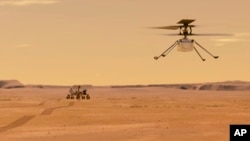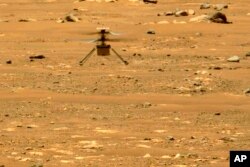NASA’s experimental helicopter, Ingenuity, has officially ended its service on Mars after what the U.S. space agency called a “history-making” mission.
Ingenuity arrived on Mars with NASA’s Perseverance explorer, or rover, in February 2021. The experimental helicopter has completed many test flights on the Red Planet to support NASA’s efforts to build new aircraft that can fly in the atmospheres of other planets.
Ingenuity became the first aircraft to complete a powered, controlled flight on another planet in April 2021.
At first, NASA described Ingenuity as a demonstration mission that was expected to last about one month. The aircraft aimed to test flight on Mars, including taking off, flying short distances and landing. The helicopter quickly demonstrated its abilities during a series of tests.
In May 2021, NASA officially extended Ingenuity’s experimental mission. In total, the helicopter performed 72 flights on Mars, the space agency said. The aircraft flew 14 times farther than planned and completed more than two hours of total flight time.
NASA Administrator Bill Nelson praised Ingenuity as “the little helicopter that could.” He noted that officials were surprised with each new flight progression.
But Nelson noted that because of damage to a rotor, the helicopter had finally taken its last flight. “The historic journey of Ingenuity, the first aircraft on another planet, has come to (an) end,” he said.
Nelson added that mission controllers discovered during an attempt by Ingenuity to land that at least one of the aircraft’s rotor blades had been damaged. The damage is currently being investigated, but the NASA chief said the blade might have struck the ground during the landing attempt.
NASA said Ingenuity rose to 12 meters on its final flight last week, staying in the air for a few seconds before heading back down. Most flights only last a few minutes because the helicopter has energy and temperature limitations.
Nelson said the helicopter was able to fly effectively in the thin Martian atmosphere. But he noted that additional progress showed the aircraft “far exceeded what we thought possible.”
Ingenuity’s mission, Nelson, said, had opened the door to “future flight in our solar system and smarter, safer human exploration to Mars and beyond.”
After Ingenuity performed well in flight tests, NASA decided to expand the helicopter’s mission to assist Perseverance with its rover operations. This change officially turned the aircraft’s mission into an “operations demonstration.”
NASA reports Ingenuity helped to identify additional exploration areas for Perseverance. Both the rover and helicopter have been collecting data and images while exploring an area known as Jezero Crater. The goal is to search for signs of ancient life on Mars.
NASA noted that Ingenuity had helped map a path from above to help Perseverance take on new exploration activities. Flight controllers on the ground have been collecting data on all of Ingenuity’s operations. They said this data will be valuable in helping NASA design future aircraft for Mars.
The success of the helicopter mission led the space agency in 2022 to approve the development of two small helicopters to be deployed on future missions.
While Ingenuity continued its operational mission, teams on the ground experimented with new rotor blades. During ground tests completed last year, engineers reported the rotor blades had reached speeds nearly equal to Mach 1, the speed of sound.
The blades tested on Earth are made of carbon. They are more than 10 centimeters longer than Ingenuity’s and are designed to be stronger and to move faster. NASA has said the rotor blades are designed to support bigger, more complex helicopters.
I’m Bryan Lynn.
Bryan Lynn wrote this story for VOA Learning English, based on reports from NASA, The Associated Press and Reuters.
________________________________
Words in This Story
mission – n. the flight of a spacecraft to perform a certain task or job
rotor blade – n. thin, flat pieces of material that spin to make aircraft lift off the ground and travel
journey – n. the act of traveling from one place to another
exceed – v. to go over a particular number or amount












Forum